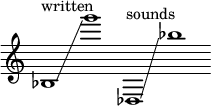Alto sarrusophone
High pitched member of the sarrusophone family of wind instruments
 Alto sarrusophone in E♭, Metropolitan Museum of Art, New York | |
| Woodwind instrument | |
|---|---|
| Classification |
|
| Hornbostel–Sachs classification | 422.112 (Double reed aerophone with keys) |
| Inventor(s) |
|
| Developed | Mid 19th century |
| Playing range | |
 | |
| Related instruments | |
| |
| Builders | |
Historical:
| |
| More articles or information | |
Sarrusophones:
| |
The alto sarrusophone is the alto member of the sarrusophone family of metal double reed instruments. Pitched in E♭, its body is folded only once, and has a bocal that resembles the neck of a tenor saxophone.
Historically it was built in the late 19th and early 20th centuries principally by its inventor, Parisian instrument maker Pierre-Louis Gautrot [fr] and his successor, Couesnon & Co. [fr], as well as Evette & Schaeffer (now Buffet Crampon) and Romeo Orsi of Milan. It is currently only available by custom order, from Orsi or German instrument maker Benedikt Eppelsheim.[2][3]
References
- ^ Blaikley, D. J. (2001). "Sarrusophone". Grove Music Online (8th ed.). Oxford University Press. doi:10.1093/gmo/9781561592630.article.24597. ISBN 978-1-56159-263-0.
- ^ "Instruments Made on Request". Milan: Romeo Orsi. Archived from the original on 18 June 2009.
- ^ "Custom Made". Munich: Benedikt Eppelsheim Wind Instruments. Archived from the original on 22 June 2017. Retrieved 11 November 2022.
External links
 Media related to Alto sarrusophones at Wikimedia Commons
Media related to Alto sarrusophones at Wikimedia Commons
- v
- t
- e
- Sopranino sarrusophone
- Soprano sarrusophone
- Alto sarrusophone
- Tenor sarrusophone
- Baritone sarrusophone
- Bass sarrusophone
- Contrabass sarrusophone
 | This article relating to double-reed instruments is a stub. You can help Wikipedia by expanding it. |
- v
- t
- e









